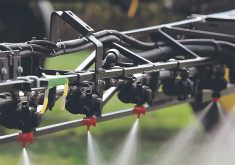Auto-steer appeared on the market in the late 1990s and was quickly picked up by farmers.
Variable rate technology had hit the market a few years earlier, in 1996, but is still having trouble convincing farmers it’s worth the price and bother.
The recent financial struggle at Farmers Edge is the latest example of how difficult it can be for the sector to pick up and retain customers.
But why the resistance?
As-yet-unpublished research by an international team of academics suggests that perhaps it’s because of farmers’ broader understanding of the technology’s true, on-farm economics.
Read Also

No special crop fireworks expected
farmers should not expect fireworks in the special crops market due to ample supplies.
The researchers say the resistance many farmers show toward embracing certain new technologies is not an enigma that defies rationality, as technology promoters have suggested.
Rather, it is seen to be the result of individual farmers more comprehensively assessing the overall costs and benefits of the technology on themselves as individuals, on their family’s life and on their farm operations.
“There are non-monetary costs that have to be brought into the conversation too,” Tomas Nilsson, an instructor and researcher at Olds College in Olds, Alta., said about the research, which is still going through the peer-review process.
“There is an impact on your human capital.”
If a technology can quickly and easily improve the life of a farmer, such as auto-steer, then the decision to embrace it is a relatively easy one.
If the technology requires considerable training and a heavy management commitment once it is operating, farmers can see it as a much less attractive option.
For many farmers, VRT appears to be the latter.
“All the data that is generated on a farm needs to be cleaned,” said Nilsson, who is one of four authors of the new research.
Farmers can pay for somebody to clean and analyze the data spewing out of their equipment, or they can do it themselves.
“It’s going to cost you time and money and sweat and tears sitting in front of the computer, too,” said Nilsson.
“It’s about finding the tradeoff…. It allows you to do more with less, but it does require you to do more.”
Nilsson collaborated with Terry Griffin of Kansas State University, LaVona Traywick of the Arkansas Colleges of Health Education and Arturo Gonzalez de Cosio of the Instituto Tecnologico y de Estudios Superiores de Monterrey in Mexico.
Griffin and Traywick had looked specifically at farmer ambivalence toward VRT in a 2020 paper in the Journal of Applied Farm Economics.
The new research with Nilsson and Gonzalez expands on that paper to include analysis of five other technologies: automated guidance, automated section control, imagery, precision soil sampling and yield monitors.
Griffin had previously looked at farmer decision-making with technology adoption and found that producers take a more holistic view of the impact of new technologies than promoters usually exhibit.
Technology proponents see the value of some of today’s systems as no-brainers and might be bewildered by farmers’ reluctance to embrace them.
However, farmers know that every decision to incorporate new technology requires an element of new and possibly increased management.
With systems such as auto-steer and automated section control, farmers can see quick gains coming relatively easily and quality-of-life improvements that allow them to better work and live as farmers.
Other systems, including VRT, don’t necessarily offer that quick reward. It’s difficult to prove to producers who do embrace them that they actually save money, improve farm production or reduce labour demands.
And many farmers definitely see them demanding significant training or additional management.
The researchers write in their analysis that farmers then look at those new demands and compare them to other activities to which they could dedicate their time.
It may be particularly difficult to convince older farmers that incorporating a demanding new system is the best use of their time, attention and money. They may learn new digital skills more slowly, have limited years left in farming and are financially more secure than younger farmers.
The economic analysis of farmers’ decisions around new technology has sometimes ignored these factors.
However, the researchers write that “human capital” is a very real part of on-farm economics for farmers. They don’t just scribble out the likely financial costs and benefits of new technology in isolation, but consider them in combination with the more intangible, overall impact on the farm, the farmer and the family.
“Some of these technologies do have an impact on your quality of life,” said Nilsson.
Acceptance is likely to be limited if a technology can’t prove its value to farmers, who already must juggle multiple demands.
Technology promoters and service providers might be befuddled when they hear farmers say, “it’s not for us (and) it’s not where we’re going to go,” but for the individual farmer, it can make good economic sense.
















